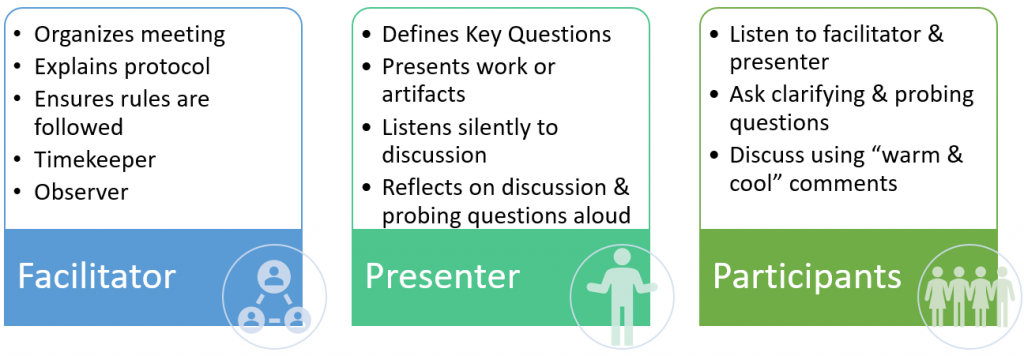
Education protocols are guidelines for efficient, respectful and productive discussions about teaching practices. Though many different education protocols have been developed, all attempt to provide participants with a safe space for sharing and improving their own or others’ teaching and coaching practices.
Technology Coaches can use protocols in their own coaching practice, as participants in PLCs or other working groups within their school, and with other coaches for their own professional development. In doing so, they will be supporting ISTE Coaching Standard 6: “Content Knowledge and Professional Growth.”
- Learning to apply protocols as part of coaching others supports standard 6b, “Engage in continuous learning to deepen professional knowledge, skills, and dispositions in organizational change and leadership, project management, and adult learning to improve professional practice.”
- Applying protocols to one’s own coaching practice supports standard 6c: “Regularly evaluate and reflect on their professional practice and dispositions to improve and strengthen their ability to effectively model and facilitate technology-enhanced learning experiences” ISTE (2011).
What is an Education Protocol?
“Protocols allow groups to explore ideas deeply through student work, artifacts of educator practice, text relating to education, or problems and issues that surface during the day-to-day lives of educators.”
Easton, 2009, p. 8
Education protocols are structured meetings that usually include a facilitator, presenter, and participants whose roles are shown in Figure 1. Protocol meetings usually last about an hour.

Example of an Education Protocol
A meeting following the Tuning Protocol (Easton, 2009), would typically look like this:
- Introduction (5 minutes): Participants, if they don’t already know each other, introduce themselves and the facilitator describes how the protocol works.
- Presentation (15 minutes): The presenter describes the topic and the key questions they would like to explore. Student work, or a copy of a lesson or coaching plan may be provided for participants to examine silently during this time.
- Clarifying Questions (5 minutes): Participants ask only questions that require short, easily answered responses from the presenter.
- Individual Writing (5 minutes): Participants and the presenter are given 5 minutes for writing with the presenter’s key questions in mind.
- Discussion (15 minutes): Participants discuss their thoughts about what they have seen/heard. During this time the presenter often steps back from the group in order to allow participants to focus on the lesson or plan, rather than the presenter. This also allows the presenter to listen carefully and take notes.
- Presenter Reflection (15 minutes): The presenter comments aloud on what they heard in the discussion, “…using the issues the participants raised to deepen understanding and reflecting on possible answers to questions posed” (Easton, 2009, p.36).
- Debrief (5 minutes): All members thank each other for their work, discuss the protocol’s effectiveness and any lingering questions, ideas, next steps associated with what was covered.
Why Use Protocols?
Some people (I have been one of them) may balk at the rigid structure of protocols. However the structure is what gives protocols their power. By organizing the conversation and assigning roles to participants, a group of teachers or coaches is more likely to remain on task and gain useful knowledge or information in a relatively short period of time. Protocols like the Tuning example above also help ensure that feedback remains focused on the work being discussed rather than the person presenting. Using protocols regularly help professional teams build trust because they know their time won’t be wasted, all voices will be heard, and their work and feelings will be respected. Team members come to view each other as valuable sources of support and learning, contributing to their own job satisfaction and the overall health of their organization.
Tips for Protocol Use
- Choose the right protocol for the task. Lois Brown Easton’s book, Protocols for Professional Learning (2009) suggests various protocols for examining student work, professional practice, addressing issues and problems, and facilitating effective discussions. The National School Reform Faculty website is also an excellent resource.
- Set up norms of discourse for the group
- Follow the protocol! Easton (2009) says that if you must cut time out of the protocol, do it proportionately for each segment of the meeting.
- The facilitator can be a participant, but they should always state which role they are playing at a given time. Easton notes that doing both can be difficult. (2009, p. 26)
- Be sure that participants understand the difference between Clarifying and Probing questions. Thanks to Les Foltos for directing me this great resource on distinguishing between the two.
- Facilitators should make sure that participants use a balance of “warm” and “cool” comments during the discussion stage. Warm comments let the speaker know what works or should be enhanced. Cool comments “…are a statement of wonder” such as “I wonder what would happen if…” They are not negative but “…promote rich thinking and substantive discourse and protect the presenter from being verbally beaten up, which is what educators who bring their practice to their peers fear most” (Easton, 2009, p. 13).
- Don’t skip the debriefing step. It is important to get feedback from participants on the process.
Examples of Protocol for Learning and Assessment
This Edutopia article features three different schools’ approaches to facilitated groups of teachers working together to improve instruction. Two of the three examples included classroom observations followed by protocol-driven discussions, while the third describes a protocol to review student work samples from a lesson. All the videos included in the article are worth watching, but I especially liked the “Learning Walks” video (below) because it shows not only the benefit of the protocol format, but the power of observing fellow teachers during a lesson. I can imagine how a technology coach could facilitate these walks so that participants could see how other teachers in their building are using technology in their lessons.
Protocols for Coaching
Foltos in his book Peer Coaching describes using the Atlas Group’s Wows and Wonders Protocol for a group of new coaches meeting to talk about the successes and challenges they faced in their new roles. The facilitators used this protocol to “…structure the discussions, to focus conversations, to drill deeper into the topics being discussed, and to ensure that coaches had clear ideas they could take away from these activities” (2011, p. 154).
For coaches who are also classroom teachers, Jarvis et. al. (2017) in Peer Coaching that Works describe a protocol (Figure 2) in which a triad of teachers identify areas to work on and use video or live observation as the basis for their discussion. Members of the triad cycle through the roles of Coach, Coachee, and Facilitator.

Resources
National School Reform Faculty – Protocols & Activities from A to Z This literally lists every education protocol imaginable. It’s a bit overwhelming but offers something to fit every need. There is a paid content section specifically for coaches, but this is in the open access part of the website: https://www.nsrfharmony.org/wp-content/uploads/2017/10/peer_observation_guide.pdf
Protocols-Coaching Conversations from Harvard’s Center for Education Policy Research These are resources for coaching teachers based on video observation.
McRel International Peer Coaching that Works
References
Boss, S. (2018). 3 ways to unlock the wisdom of colleagues. Edutopia. Retrieved from: https://www.edutopia.org/article/3-ways-unlock-wisdom-colleagues
Easton, L. B. (2009). Protocols for professional learning (the professional learning community series). Retrieved from https://ebookcentral-proquest-com.ezproxy.spu.edu
Foltos, L. (2013). Peer Coaching. Thousand Oaks, CA: Corwin.
ISTE Standards, Coaches (2011) Retrieved from: https://id.iste.org/docs/pdfs/20-14_ISTE_Standards-C_PDF.pdf
Jarvis, R., Dempsey, K., Gutierrez, G., Lewis, D., Rouleau, K., & StonePeer, B. (2017). Peer coaching that works: The power of reflection and feedback in teacher triad teams. McRel International. Retrieved from: https://files.eric.ed.gov/fulltext/ED588635.pdf
Great insights into the power of protocols for educators. Can’t wait to hear about your experiences when you have more opportunities to try them with peers. Resources also are powerful for those just dipping their toe into the use of protocols.
Bridget- I love that your focus for this blog post is protocols! I have been eager to learn more about protocols and am so thankful for the information you provided. The idea of having a safe space for sharing and growing within your profession is something I feel many educators would be thankful for. The examples of protocols you provide as well as the visual of the learning walks was very informative. I appreciated that you not only gave examples and tips to implementing protocols, but you also discussed the importance of why educators, coaches, and other professionals should use them. Great work and as always thank you for sharing!
I love that your title starts us off with what is at the heart of using protocols which is helping to create a safe haven for discussions. When there are multiple participants in discussions, the main topic/idea/focus can quickly erode away without a solid protocol guiding the way. When you speak to the importance of time management, the part that really stuck with me was if you need to cut time to do so equally – seems so obvious but often just one chunk gets the brunt of being cut which really changes the positive effect protocols can have – thank you for bringing that to my attention! Wonderful resources and I know I will go back to this post as my journey with learning leadership and coaching skills continues.
Bridget, thanks for the research and resources you put into this blog post. I liked your reminder that protocols help everyone engage and stay more on task. Our district has adopted a protocol for giving PD’s that I have really appreciated. It is thoughtful, consistent and allows time for collaboration and reflection (which I sometimes feel is missing in trainings, especially when trying to cram in lots of information). Thanks for all your informative coaching blog posts this quarter. I always look forward to reading what you have discovered!